Dante, AES 50, AVB: What audio networking format is right for you?
Audio Networking is becoming an increasingly important part of live and studio setups. But what’s the difference between all the networking formats? Do you know your Dante from your AVB? And which networking format should you choose? Grab a coffee and let us guide you through the maze of audio networking protocols.
What is Audio Networking?
Up until a couple of decades ago, if you needed to send multiple channels of audio over long distances, you had few choices. Typically you’d be running audio over balanced line analogue cabling, using physical patch bays and distribution amplifiers. The analogue approach has some notable downsides though: cable cost, maintenance and limitations of cable length.
With the advent of digital audio it’s now possible to send multi-channel audio down a single Ethernet cable. You can even distribute those channels to multiple sources, format depending. Importantly, this means no more expensive, bulky multicore snakes, no loss of audio quality over distance and much more flexibility in routing.
Sounds great? Well, there are multiple audio networking formats and worse, they are not mutually compatible! So what are your choices and what should you be looking for when you buy your next digital mixing console? We thought it was about time we had a quick round-up of the most common audio networking formats. All have their own pros and cons but it’s important that you choose the format which suits your requirements… and budget!
Dante
If you’ve worked with or looked into network audio, it’s inevitable you’ll have come across Dante. Introduced around the mid-noughties, Dante has almost become the generic trade term for networked audio. Importantly, Dante is the only network system with which you could build a complete system from microphone to mixing console, to speaker system wholly on a single audio network.
You’ll find more pro audio gear offering Dante network support than any other audio networking format, either built-in or via accessory networking cards. Dante also runs over your existing Ethernet network as it uses IP packets for data transfer. The major downsides to Dante for you, the user, are cost and complexity. You’ll find Dante equipped hardware is expensive thanks to chipset licensing costs. Dante’s control software is also, how shall we put this… challenging to use! There are certified courses in Dante networking for example…

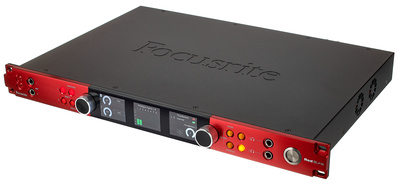
Pros
- Runs over standard Ethernet network
- Greatest support of any audio networking format
- Best prospects for long-term support
- The “Industry-Standard” for mid to high-end pro audio
Cons
- Dante-equipped hardware is expensive due to licensing costs
- Dante control software not easy to use with many stages of “certification” for those wishing to master the technology
AVB
Audio Video Bridging or AVB is another audio networking format you’re likely to have heard of. An open-source format under the designation of IEEE 1722, you may also have come across it branded as Milan in pro audio systems. AVB has many similarities with Dante in that it’s a way of sending network audio over an Ethernet network. Well, when we say Ethernet network, there are some caveats
The designers of AVB identified an issue with sending latency-sensitive information, such as audio and video, over Ethernet. As data is sent as packets, it can sometimes be “held up” in a queue of data. AVB uses the concept of time-sensitive networking which means your audio or video data carries special priority flags to reduce latency. (NB: since publishing this article, it transpires typical Dante latency can be as low as 125u seconds which is, in fact, lower than the 2ms of AVB)

One of the biggest issues with AVB is that it requires AVB certified Ethernet hardware. Whilst this hardware is 100% backwards compatible with regular Ethernet, it does add extra cost, complexity and incompatibility. On the flip-side, because AVB is open source, the hardware tends to be more affordable as there are no licensing costs.
Unfortunately, industry adoption of AVB has been minimal, with perhaps only Presonus and MOTU building their audio networking gear around AVB. At the time of writing, it’s an uncertain future for AVB in pro audio. Many manufacturers who originally championed AVB are now offering Dante interface solutions for many of their existing AVB equipped product ranges.


Pros
- Theoretically lower latency than Dante thanks to time-sensitive networking
- Lower cost as an open-source format
- AVB hardware compatible with existing Ethernet cabling and architecture
Cons
- Requires AVB certified Ethernet switches and hardware
- Low industry takeup and uncertain future in pro-audio
AES50 as a Audio Networking format
When is an audio network not an audio network? Answer: when it’s AES50! AES50 is an open-source audio networking format for multi-channel audio carried over regular CAT5 networking cable. Now, strictly speaking, AES50 isn’t an audio networking format as it’s inherently a point-to-point connection protocol. Think about a mixing desk connected to a stage box; that’s a classic point-to-point setup.
We’re including AES50 here as it’s one of the most commonly found ways of connecting multichannel audio gear over CAT5 cable. AES50 is also used extensively by Midas and Behringer, with consoles such as the X32, M32 and Wing offering Dante networking solutions. As a result of those desk’s ubiquity, you’re likely to encounter AES50 in most modern live venues and project studios.
Remember we said AES50 isn’t an audio network format? Well, that doesn’t mean you can’t create an audio network based around AES50. AES50 can be networked using specialised routers via centralised “star network’ topologies. It’s also possible to buy interfacing solutions to connect your AES50 gear to Dante networked hardware for example.
Music Group’s adoption and inclusion of AES50 has assured it a strong place in the live sound industry. We expect this open-source format to remain as the default connection for interconnecting consoles and stage boxes, for example.

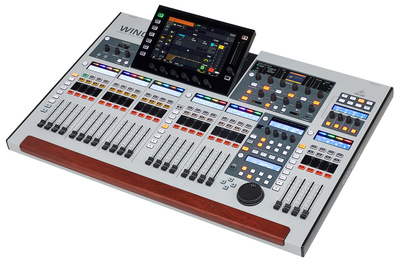
Pros
- Extremely low (practically nil) latency in operation
- Low cost as an open-source format
- Ubiquity thanks to Music Group adoption (X32, M32 ,Wing)
- Can be interfaced and networked with Dante via 3rd party hardware
Cons
- Doesn’t natively support networking
- Requires specialised hardware to create an audio network
Other Proprietary Formats in Audio Networking
You might be reading this and shouting at the screen, “But my mixing desk doesn’t use any of those networking formats!” Yes, there are audio networking formats aside from those we’ve already mentioned. Worthy of note are Allen & Heath’s gigaACE, and Waves Sound Grid which you’ll find on DigiCo, Yamaha and even Allen & Heath desks! There are also some older legacy formats such as CobraNet which is the granddaddy of audio networking formats.
We haven’t gone into detail on these formats, because in our opinion the future of things seems fairly clear cut. Allen & Heath, DigiCo and Yamaha all offer Dante networking cards for their professional range of mixing consoles. If that isn’t an admission that Dante is emerging as the dominant industry standard, we don’t know what is! None the less, it’s a good idea to familiarise yourself with these other formats, if only to be aware of what gear will work seamlessly together.
What Audio Networking Format Should I Choose?
Ultimately, your choice of networking format will be governed by budget, application and to some extent the mixing console you feel most comfortable with. Dante offers the only networking format which can be supported cross-platform. It seems almost every manufacturer is offering Dante plug-in cards or native Dante support nowadays making it a “future-proof” solution.
With that said, if all you need is a simple point-to-point connection from desk to stage box, AES50 is simple and affordable and may well be all that your application requires. AVB networking offers much on paper, but its requirements for dedicated switches and lack of wider industry adoption means this may well be the “Betamax” of audio networking.
What do you use in your day to day productions? Have you dipped your toes in the water of audio networking yet? Drop us a comment and let us know what format you’re using!
- focusrite-pro-red-8line: Focusrite Pro
- Behringer's Wing DIgital Mixer: Behringer
9 responses to “Dante, AES 50, AVB: What audio networking format is right for you?”

 4,6 / 5,0 |
4,6 / 5,0 | 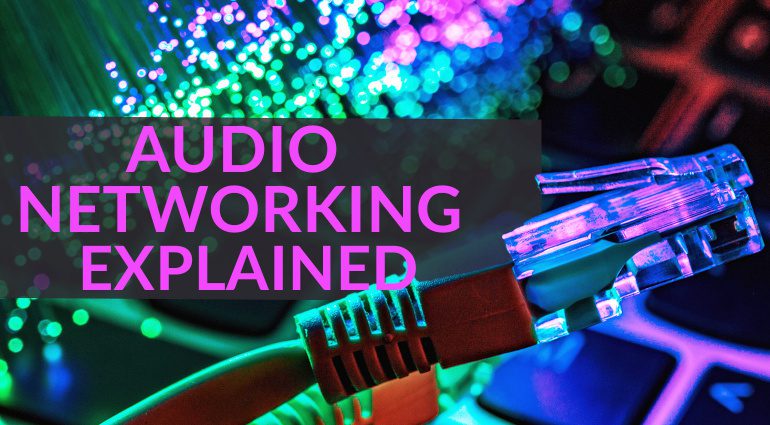




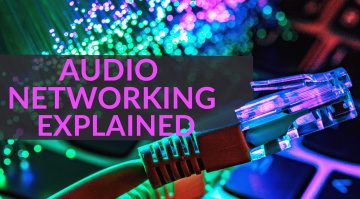

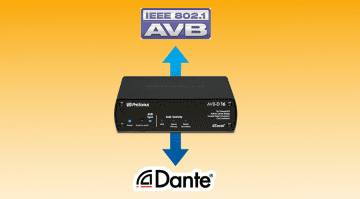
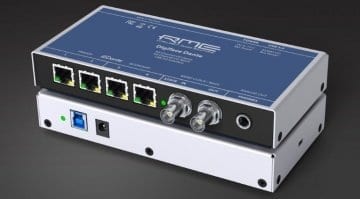
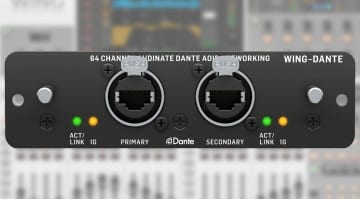
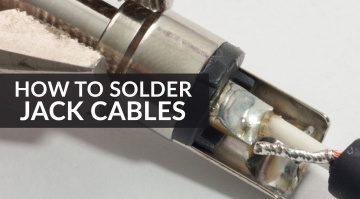
There are some fundamentally flawed statements in this article.
Predominantly relating to costs and “complexity” of Dante Systems.
Network switches for AVB are on average at least 3x the cost of network switches for AVB, and the comments regarding latency are incorrect too.
Dante latency can be selected to be as low as 125uSeconds.
Please address these factual errors.
Hey Liam, thanks for your reply. let me try and address your points in turn:
COSTS
As mentioned in the article, AVB requires certified network switches which are more expensive than regular Ethernet switches as used by Dante.
The flipside is that Dante hardware is typically more expensive than AVB systems and especially more so than AES50 systems. This is an avoidable factor caused by Audinate’s monopoly on the chipsets implemented by manufacturers. That cost has to be passed on to the customer.
LATENCY
Theoretically, AVB should offer lower latency than Dante due to time-sensitive networking. However I am happy to concede that if in practice you’re seeing latency as low as 125u seconds that’s lower than AVBs typically 2ms.
AES50 still offers the lowest latency of all however at 63us. In reality would any of this be noticeable in a live venue? It’s debatable!
COMPLEXITY
I have yet to meet a fellow live engineer or systems engineer that hasn’t had a gripe about how difficult Dante is to work with. I’ve also spoken with academic institutions with large Dante networks complain about how unintuitive Dantes networking software is. I’m happy to stand my ground on it being a complex system to use, if not to implement physically.
I’ve worked with Dante and am getting more and more jobs that already have it in the infrastructure or it just makes sense to use it.
For my own rig, I was looking into Dante but with the recent announcement of the Pro Tools Carbon, I may go AVB with hopes that Avid will be expanding on the platform.
Over all good article…pretty solid base for a starting point. Kind of an old article to be commenting on in this context having been out for several months now and I know you probably couldn’t mention every protocol out there, but I’m surprised to see no mention of AES67 (or SMPTE 2110, though it’s total scope might be outside this article as it also incorporates video and the audio portion is basically AES67.) It may be very similar to Dante, and perhaps that is why you didn’t mention it, but it is not Dante. Specifically to the article’s cons list for Dante, it doesn’t offer all the other features of Dante but is (perhaps too simply put) an open source AES standard version of the audio portion of Dante. In fact (as far as I know anyway and acknowledging it doesn’t go the other way if you have an older and/or incompatible version) all current Dante firmware is compatible with AES67 opening up both standards to a wider potential base. The monopoly you mention that Audinate has is the same one Cirrus Logic has (had?) on CobraNet. It’s basically their proprietary protocol; they just did a really good job of selling it. So yes, if you do a full Dante implementation, you’re getting your chipsets from Audinate, but if you only do AES67, you could conceivably go elsewhere negating the licensing cost con you mentioned and still be compatible with most of the existing Dante base.
I’ll also concede the cost and complexity statements as presented, but only to a point.
In my experience the cost differences aren’t as great as you’ve implied when factored into the cost of a complete system. Is it more for the hardware? Yes. Is it break-the-bank more? Not usually and I’ve generally been able to at least come in equivalent if not a little cheaper for Dante systems over the alternatives. First, I personally have found AVB enabled systems to be fairly comparable in cost to Dante enabled systems when compared to a non-network enabled version of the same product so not sure where your data is coming from. You do make a good point that AVB could or should be less being open source though and maybe you’re looking at different products than I have. Second and following off that, the reduced cost afforded by off-the-shelf network hardware usually more than makes up for any increase caused by the cost of the chipsets in my experience. Third, I find most cost increases to be just as much natural differences in quality levels as it is the addition of network connectivity regardless of format…lower end products aren’t as often network enabled to start with and higher end products cost more to start with. And of course forth, the cost savings in Cat5/6 cable vs standard audio cable factors in when looking at the complete system. As an effectively proprietary protocol even though it is open source (Music Group being the primary implementer as you’ve mentioned) and due to it not being natively network based in this context limiting it’s usefulness in the systems I typically deal with, I haven’t used AES50 as often and can’t speak to it’s relative costs.
As for complexity, it can be complicated and maybe it isn’t as intuitive “out of the box” as you may want it to be or it could be, but I have found a lot has to do with getting used to how it works with the receive and transmit channels (some people just have a problem wrapping their heads around it for some reason) and actually taking the training courses. I’ve never really had a problem with it myself but I know lots of people that have. In almost all cases the people that have the most trouble with it are also the people that have the most trouble with networking in general and/or haven’t taken the courses. You may argue that it should be intuitive enough to not need a training course, and to some degree you have a point, but the training courses Audinate put together actually address the network as well to address the issue of people having issues setting up the network to start with so they aren’t just Dante and are actually pretty useful on their own. (Having taken all 3 levels of the Dante certification courses, I’d recommend anyone working in Pro Audio in today’s environment take them.) On top of that I’d argue that any system coupled with a user base that is unfamiliar with the basic concepts of that system will instantly turn unintuitive. (I do a lot of trainings for schools for example where the part time drama teacher can barely turn the audio console on. For that audience, it doesn’t matter what Audinate did with the UI design, it would be very complicated for them.) That said, “out of the box” for a basic system, you’re generally talking straight crosspoint matrix routing with the Dante Controller software…pretty easy once you figure out the terminology. It isn’t till you get into systems which are inherently complicated to start with such as the university example you gave that the complexity really starts coming through and you have to “stop and think” about what you’re doing and get into the guts of the software, and any other network system I’ve used has had the same types of complexities in the configuration environment in those situations. It’s a new world out there where you almost need to be a network technician in addition to an AV technician. It’s going to take more and continuing training to keep up with technology advances and a lot less of the analog days of “I know the basic layout of this console and that console is just bigger/newer/etc.” In short, technically the complexity is a con, but not much of one in my opinion.
Well done! Thank you for the clarity, for linking to the related videos, and for the concise overview.
I have been using Dante for a few years now. It makes life so much easier. in a typical event RF is Dante enabled, Video switcher is Dante enabled and amp rack are all AES3 so very little left that is no on the network. no more buzzes no more “oh I need a split head for the broadest truck”
Nice info, but it would be good to have some discussions on the issues below.
1. Dante requires Dante enable components. If one has an AV setup, then in order to use Dante on to setup an AV network one must change out any device that doesn’t have a Dante chip. If one is planning on replacing their mics, mixer, computer, cameras, etc, with a Dante capable one, then the cost are less of an impact. However, if one prefers not to replace these components then using Dante can be cost prohibitive (because one would have to buy at least one interface box for each component), or impossible. A switch that allows one to use any AV component seems more acceptable than being limited to an AV component because it doesn’t have Dante. I would be very interested in feedback regarding integration of Dante with legacy equipment in a cost effective way.
2. It seems that all discussions across the internet on Dante is audio focused. So it is unclear whether or not Dante is really up to the task of managing Video recording across a network. To do this would one need a Dante network switch? If so, then the generic switch argument drops off the table. I would enjoy getting more insight on this.
I know these comments are focused on Dante, but I imagine they are the same with any similar technology requiring embedded chips in the source.
I sure hope AVB survives. I have 128/128 MOTU/Presonus AVB system that just works! The routing is so flexible and I never have any problems with my setup.
AVB and DANTE\AES67 are so different that they are not really competing. Neither have native support on Windows. Meaning that they won’t work with the standard network interface and drivers in your pc. Which currently means AVB on Windows is only useful for expanding a usb or thunderbolt interface with extra interfaces over AVB. But total amount of channels on the pc are then limited by the usb\thunderbolt interface capacity.
Dante and AES67 are designed for large switched IP networks. They do work over standard network switches, but managed switches for realtime audio (QoS) are not cheap either. If you have more than a few devices it’s not really fun for musicians anymore.
You are currently viewing a placeholder content from Facebook. To access the actual content, click the button below. Please note that doing so will share data with third-party providers.
More InformationYou are currently viewing a placeholder content from Instagram. To access the actual content, click the button below. Please note that doing so will share data with third-party providers.
More InformationYou are currently viewing a placeholder content from X. To access the actual content, click the button below. Please note that doing so will share data with third-party providers.
More Information